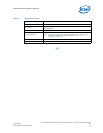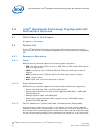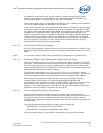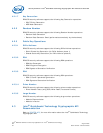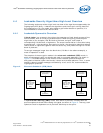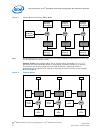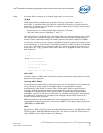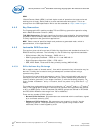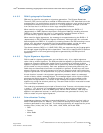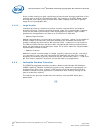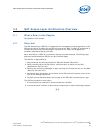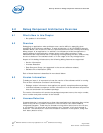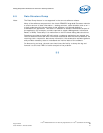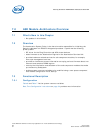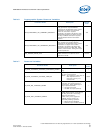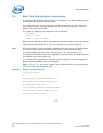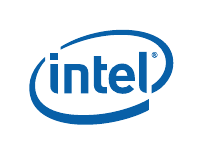
Intel
®
EP80579 Software for Security Applications on Intel
®
QuickAssist Technology
August 2009 PG
Order Number: 320183-004US 27
Intel
®
QuickAssist Technology Cryptographic API Architecture Overview—Security Software
4.4.3.2 RSA Cryptographic Standard
RSA may be used for encryption or signature generation. The Chinese Remainder
Theorem (CRT) can be used as a method of RSA acceleration. CRT describes how to do
exponentiation (or multiplication) modulo a composite modulus n as a series of smaller
multiplications modulo the prime factors of n. Its cryptographic strength is derived
from the fact that it is difficult to factor large composite numbers.
When used for encryption, the message is encapsulated using the PKCS v1.5
(deprecated) or OAEP (Optimal Asymmetric Encryption Padding) encoding schemes.
OAEP is an improvement over the v1.5 (encryption) encoding scheme in that it
provides security against adaptive chosen-ciphertext attacks.
When used for digital signatures, the message is encapsulated using the PKCS v1.5
(deprecated) or PSS (Probabilistic Signature Scheme). Although there are no known
attacks against the PKCS v1.5 (signature) encoding scheme, the PSS encoding is more
robust, as it introduces randomness into the encoded message, so that the same
plaintext message will, in general, produce different encoded messages.
The above schemes (PKCS v1.5, OAEP, DSS, PSS) are supported by the Cryptographic
API through supporting RSA primitive operations. There are no specific APIs to perform
the encapsulation of the encryptions/signatures generated by the RSA primitive
operations.
4.4.3.3 Digital Signature Algorithm
DSA is used for signature generation and verification only. It is a digital signature
rather than a written signature. The DSA provides the capability to generate and verify
signatures. Signature generation makes use of a private key to generate a digital
signature. Signature verification makes use of a public key which corresponds to, but is
not the same as, the private key. Each user possesses a private and public key pair.
Public keys are assumed to be known to the public in general. Private keys are never
shared. Anyone can verify the signature of a user by employing that user's public key.
Signature generation can be performed only by the possessor of the user's private key.
A hash function is used in the signature generation process to obtain a condensed
version of data, called a message digest. The message digest is then input to DSA to
generate the digital signature. The digital signature is sent to the intended verifier
along with the signed data. The verifier of the message and signature verifies the
signature by using the sender's public key. The same hash function must also be used
in the verification process.
The underlying mathematical principle is Fermat’s Little Theorem, which states that gp-
1 mod p = 1 for p prime. Its cryptographic strength is derived from the fact that
logarithms are difficult to do in a MODP group. As with Diffie-Hellman, DSA may be
applied in an ephemeral manner, in which parameters are generated on the fly and
used to create only one digital signature.
4.4.3.4 Prime Number Testing
Lookaside provides an interface to test probabilistically if a number is prime (refer to
ANSI x9.80 specification for details). This is used for testing the primality of random
numbers generated for key material. The following algorithms are supported for prime
number sizes (in bits) 160, 512, 768, 1024, 1536, 2048, 3072 and 4096.
•GCD
•Fermat
• Miller-Rabin
•Lucas



